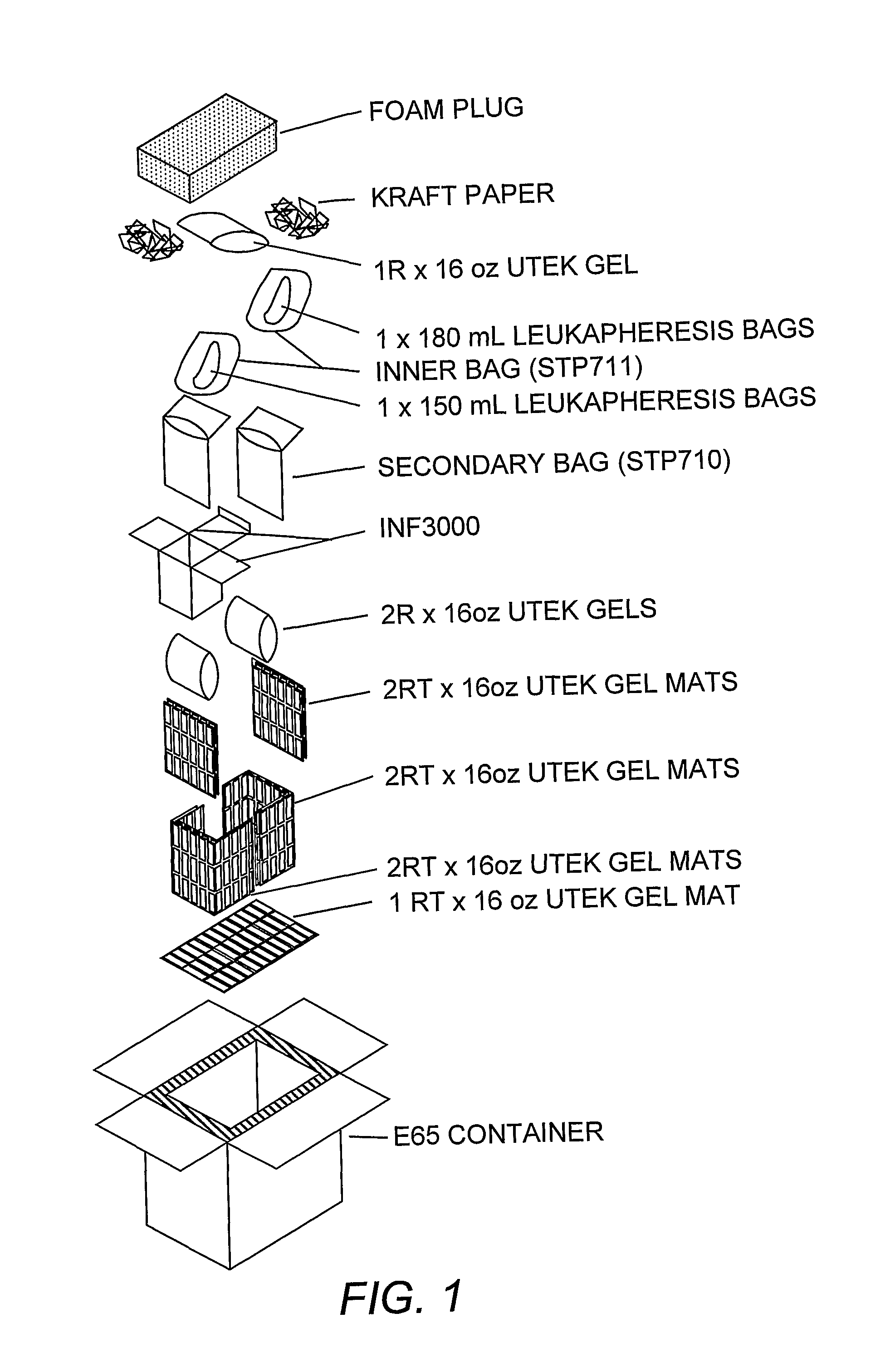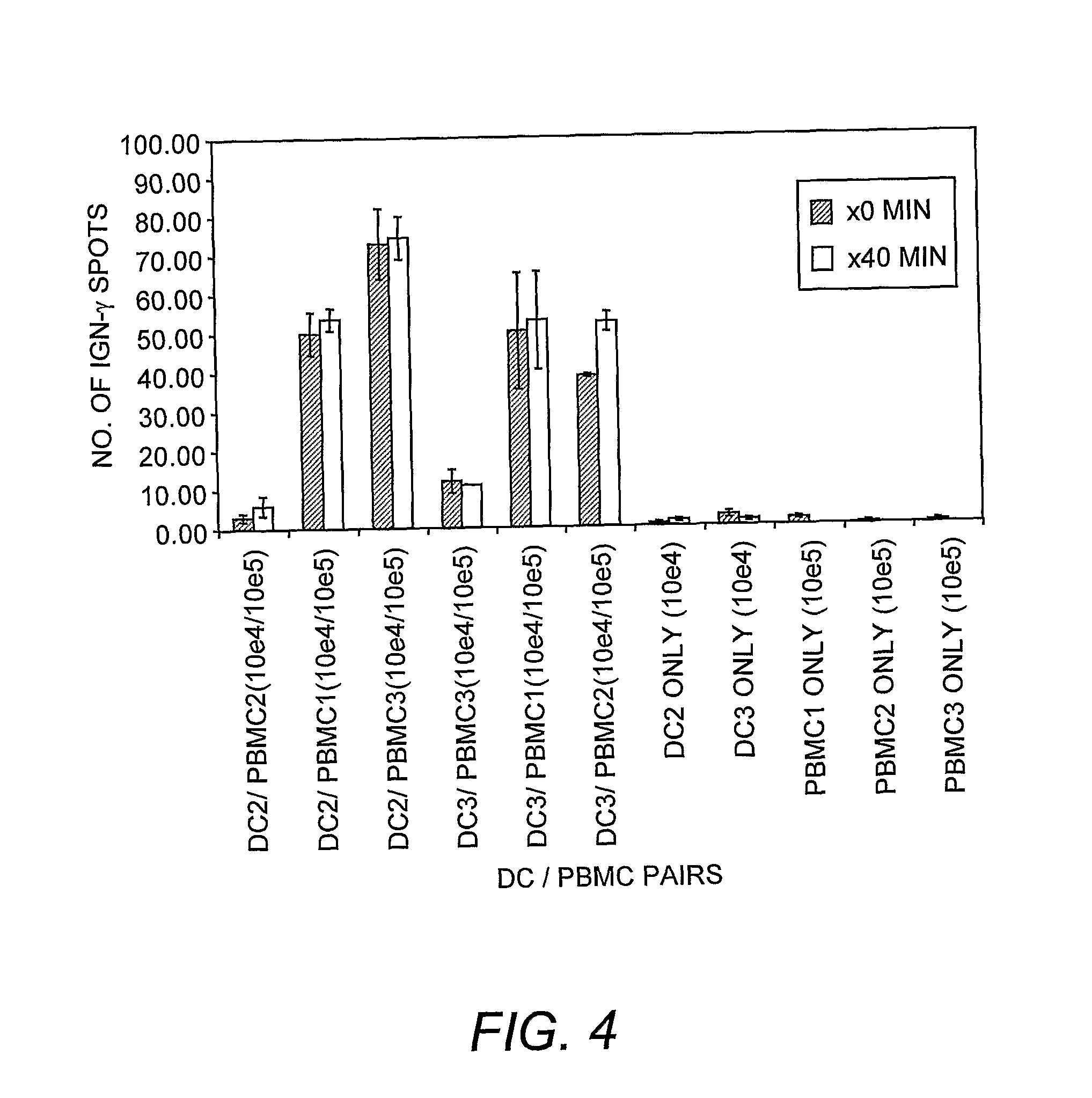Dendritic cell compositions and methods
a dendritic cell and composition technology, applied in the field of dendritic cell compositions, can solve the problems of limiting the widespread use of vaccines processed by, limiting the use of vaccines that are processed by, and requiring fresh pbmcs or monocytes to be produced, etc., to achieve the effect of increasing the level of mhc class i, reducing the risk of infection, and increasing the level of costimulatory molecules
- Summary
- Abstract
- Description
- Claims
- Application Information
AI Technical Summary
Benefits of technology
Problems solved by technology
Method used
Image
Examples
example 1
Dendritic Cell Prepared from Day-Old Leukapheresis
[0138]Peripheral blood mononuclear cells (PBMCs) were collected from 4 human donors by leukapheresis and transported by overnight delivery to a dendritic cell manufacturing facility in temperature-monitored shipping containers maintained at a temperature of 8° C.-26° C. The day of delivery, the leukapheresis product underwent Ficoll density gradient centrifugation in 50 ml conical tubes (800×g) for 20 minutes at room temperature (approximately 19-22° C.) to separate and concentrate the mononuclear cell fraction that includes the dendritic cell precursors (monocytes). After two washing steps with phosphate buffered saline (PBS), cell concentration and cell viability were determined. After the third centrifugation / washing step with PBS, mononuclear cells were resuspended in StemSpan™ H2000 medium (StemCell Technologies, Inc.) and seeded in T150 cm2 flasks at 2.0×108 cells per flask. Monocytes were then selected from the mononuclear cel...
example 2
Dendritic Cell Vaccines Prepared from Day-Old Leukapheresis Product Remain Viable for at Least 2 Hours Post Thaw in 10% DMSO
[0144]A frozen dendritic cell vaccine prepared as described in Example 1 was thawed at 37° C., and kept at 20-25° C. or at 2-8° C. for 2 hours. Viability was determined immediately post-thaw and at 30 minute intervals for up to two hours. Viability immediately post-thaw at 37° C. was 92%. The results are shown in Table 2, and confirm that the vaccine can be thawed and stored in 10% DMSO for at least two hours.
[0145]
TABLE 2Viability (%)20-25° C.2-8° C.Post-thaw time (minutes)Post-thawPost-thaw3091886089869089801208783
example 3
Isolation of Mononuclear Cells from a Patient and Differentiation of Monocytes into Immature Dendritic Cells
[0146]Peripheral blood mononuclear cells and plasma were collected from a patient or volunteer by leukapheresis at room temperature at a clinical site. The leukapheresis product (PBMCs) and serum were shipped overnight in a temperature controlled container maintained in a temperature range of 6-28° C. The day following leukapheresis, the PBMCs were purified by Ficoll density gradient centrifugation in 50 ml conical tubes at room temperature to separate and concentrate the mononuclear cell fraction that includes monocytes (the dendritic cell precursors) and leukocytes. The mononuclear cells were washed several times in phosphate buffered saline (PBS), and the cell concentration was determined. After the final centrifugation / washing step with PBS, mononuclear cells were resuspended in AIM-V medium and seeded in T150 cm2 flasks at 2.0×108 cells per flask. Monocytes were then sele...
PUM
| Property | Measurement | Unit |
|---|---|---|
| temperature | aaaaa | aaaaa |
| time | aaaaa | aaaaa |
| time | aaaaa | aaaaa |
Abstract
Description
Claims
Application Information
 Login to View More
Login to View More - R&D
- Intellectual Property
- Life Sciences
- Materials
- Tech Scout
- Unparalleled Data Quality
- Higher Quality Content
- 60% Fewer Hallucinations
Browse by: Latest US Patents, China's latest patents, Technical Efficacy Thesaurus, Application Domain, Technology Topic, Popular Technical Reports.
© 2025 PatSnap. All rights reserved.Legal|Privacy policy|Modern Slavery Act Transparency Statement|Sitemap|About US| Contact US: help@patsnap.com



